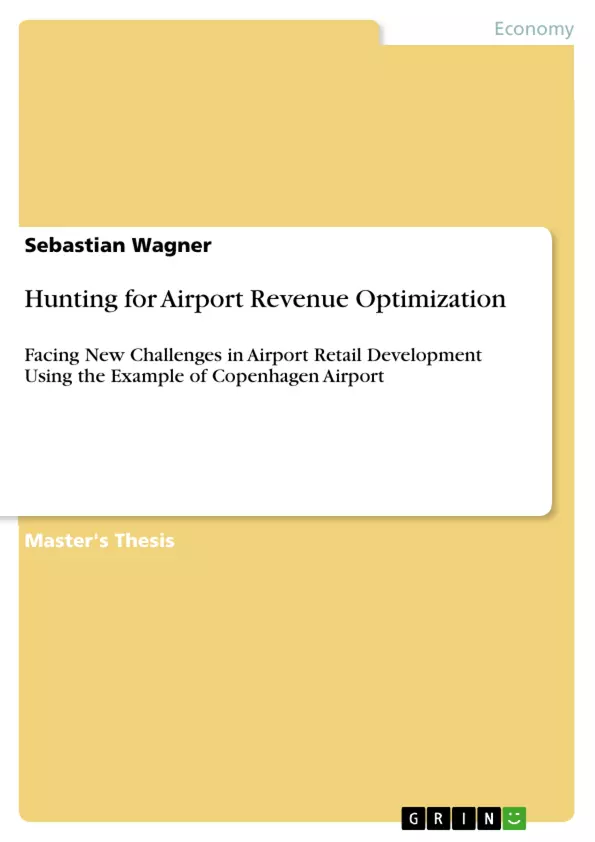The aim of this thesis is to investigate the latest challenges and trends in airport retail using the practical example of Copenhagen Airport. Driven by the steadily increasing cost pressure on European airports, operators need to develop new sources of revenue. The greatest po-tential in generating additional revenue to combine reasonable income with high profitability can be found in the non-aviation sector, particularly in the travel retail segment. The re-search, however, revealed that airport retail is not always a fast-selling item. The market experiences extensive challenges driven by advanced airline retail activities or online sales developments.
In order to face the recent challenges, the importance of commercial revenues for airport operators needs to be evaluated firstly. Moreover, characteristics and specialties of travel retail have to be analyzed. Based on that, the thesis explores some of the key factors, such as market trends, economical changes and technical developments, which are leading to an ever-challenging environment for airport retail managers. Finally, the research paper aims at elaborating resulting challenges and future opportunities by providing new ideas and solutions in optimizing airport retail for European airports in general and Copenhagen Airport in particular. To conclude the master’s thesis, a summary is presented reviewing all findings.
The overall research results reveal that Copenhagen Airport’s retail philosophy has adapted to the dynamic changes in the airport retail segment. However, there remains significant room for further improvement in order to combat future challenges on the travel retail mar-ket. Furthermore, my results and recommendations can be transferred to the benefit of other airport retail managements as well.
Inhaltsverzeichnis (Table of Contents)
- A - Abstract
- B - Table of Content
- C - List of Figures
- D - List of Abbreviations
- 1 - Introduction
- 1.1 Scope and Objective
- 1.2 Approach and Methodology
- 2 - Airport Revenue Structure, Retail & Processes
- 2.1 Airport Income
- 2.1.1 Aeronautical Revenue
- 2.1.2 Non-aeronautical Revenue
- 2.1.3 The Increasing Importance of Commercial Revenue
- 2.2 Airport Retail
- 2.2.1 The Significance of Airport Retail
- 2.2.2 Retail Categories
- 2.2.3 Airport Retail Calls for Modifications
- 2.3 Setting the Scene for Airport Retail
- 2.3.1 The Airport Travel Chain and Passengers Mindset
- 2.3.2 Shopping Motivation and Impulse Buying Tendency
- 3 - The Airport Retail Business - Concepts under Pressure
- 3.1 Different Perspectives but one Direction
- 3.2 Airline's Ancillary Revenue Growth Efforts
- 3.2.1 Airlines Push Limits of Selling Onboard
- 3.2.2 Communication Beforehand
- 3.3 Airport Retailers on the Move
- 4 - Facing Future Challenges at Copenhagen Airport
- 4.1 Copenhagen Airport - The Vision of Retail Business Excellence
- 4.1.1 CPH - An Airport Profile
- 4.1.2 CPH and the Status Quo of European Airport Retail
- 4.1.3 Airport Vision and Strategic Focus Areas
- 4.2 Extraordinary Customer Experience
- 4.2.1 Airport Shopping has gone Digital and Mobile
- 4.2.2 Engaging Customers with Social Media
- 4.2.3 'CPH Advantage' meets ‘Earn & Burn’
- 4.2.4 Redefining Luxury at CPH
- 4.3 Competitiveness
- 4.3.1 Advantage through customer surveys
- 4.3.2 Customer Segmentation and Service
- 4.3.3 Competing with Downton Retail
- 4.4 Efficient Operations
- 4.4.1 Security Control can make the Difference
- 4.4.2 Improved Passenger Guidance
- 4.4.3 Passenger Relaxation as a Booster for Retail
- 4.4.4 Successful Airport - Retailer Collaboration
- 5 - Management Recommendations
- 5.1 Competitiveness
- 5.2 Extraordinary Customer Experience
- 5.3 Efficient Operations
- 6 - Conclusion
- E - Appendix
- F - References
Zielsetzung und Themenschwerpunkte (Objectives and Key Themes)
This master's thesis explores the evolving landscape of airport retail, focusing specifically on Copenhagen Airport as a case study. The aim is to analyze the challenges and opportunities arising from increasing cost pressures and competition, and to identify potential solutions for optimizing airport retail strategies. The key themes addressed in this work include:- The increasing importance of non-aeronautical revenue for airport operators
- The unique characteristics and challenges of the airport retail market
- The impact of airline ancillary revenue growth efforts on airport retail
- The role of customer experience, digitalization, and social media in airport retail
- Strategies for enhancing competitiveness and operational efficiency in airport retail
Zusammenfassung der Kapitel (Chapter Summaries)
Chapter 1 provides an introduction to the scope and objectives of the thesis, outlining the research approach and methodology employed. Chapter 2 delves into the airport revenue structure, emphasizing the increasing importance of non-aeronautical revenue, particularly in the travel retail sector. It explores the unique characteristics of airport retail, its challenges, and the impact of the airport travel chain on passenger behavior and shopping motivation. Chapter 3 focuses on the competitive pressures facing the airport retail business, including the impact of airline ancillary revenue growth efforts. It examines how airlines are pushing the boundaries of selling onboard and the implications for airport retailers. Chapter 4 presents a case study of Copenhagen Airport, analyzing its retail philosophy, its vision of retail business excellence, and its efforts to create an extraordinary customer experience. This includes initiatives related to digitalization, social media, and customer segmentation. The chapter also explores Copenhagen Airport's approach to enhancing competitiveness and improving operational efficiency. Chapter 5 offers management recommendations based on the research findings, providing insights for improving competitiveness, enhancing customer experience, and optimizing operational efficiency in the airport retail environment.
Schlüsselwörter (Keywords)
This research centers on the evolving landscape of airport retail, focusing on the challenges and opportunities arising from increasing cost pressures and competition. Key concepts include non-aeronautical revenue, travel retail, airline ancillary revenue, customer experience, digitalization, social media, competitiveness, and operational efficiency. The case study of Copenhagen Airport provides valuable insights into successful strategies for optimizing airport retail performance.- Citation du texte
- Diplom-Kaufmann Sebastian Wagner (Auteur), 2014, Hunting for Airport Revenue Optimization, Munich, GRIN Verlag, https://www.grin.com/document/285452



